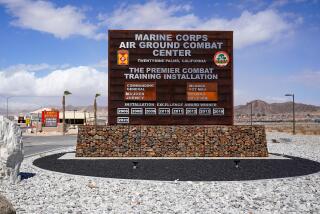Bacteria Recruited in Cleanup
- Share via
Harmless bacteria that break down toxic chemicals are one of the secret weapons behind a more than $50-million cleanup at Naval Base Ventura County that aims to remove decades of poisons and pollution.
The long-term cleanup campaign--really a series of smaller decontamination efforts throughout the 6,100-acre facility since the mid-1970s--calls for identifying and removing toxins such as gasoline, paint solvent and pesticides from soil and ground water, said environmental engineer Steve Granade, who oversees the work on the Point Mugu side of the base.
“We have tried to break it up into bite-sized pieces,” Granade told a small group of residents who gathered Thursday evening for an update on the cleanup.
The base has identified nearly 40 sites that are either polluted or warrant further study.
“None of them are threatening to the population, but there’s things you have to act on,” said Steve McCarel, the environmental restoration manager for the base’s Port Hueneme side.
The Point Mugu portion of the base has about 15 cleanup sites, which range from about 100 square feet to the 2,500-acre Mugu Lagoon, Granade said.
The lagoon contains contaminants not only from the base but from every community--from Simi Valley to Camarillo--whose water drains into Calleguas Creek. The creek empties into the lagoon, so cleanup will be a countywide effort, Granade said.
At one site, government environmental groups plan to take tissue samples of plants and animals and run toxicological tests to determine whether further action is needed, Granade said.
At another site near a painting facility, Navy environmental engineers use various bacteria that convert toxins from cleaning solvents into their harmless component elements.
The process begins by injecting lactic acid into the ground to help the bacteria grow.
“They love this stuff and they eat it,” Granade said. “The number of bacteria increases.”
The bacteria then go to work converting the chlorinated solvents in the ground. “They literally breathe the metallic solvents,” he said. “The more chlorine it has, the more they like it.”
But because part of the process produces a carcinogenic compound, engineers add a second type of bacteria, whose enzymes help finish the job.
Oxygen also will be injected into the ground to speed the final cleanup. Because two distinct types of bacteria are used, the timeline for the overall cleanup has been reduced from 15 years to about 15 months, Granade said.
Point Mugu officials this week received the first payment of $2.7 million in restoration funds for the fiscal year that ends Sept. 30, according to project manager Mike Gonzales.
The Port Hueneme side expects $1.4 million this year for cleanup, said Josh Fortenberry, Gonzales’ counterpart. That amount includes $250,000 to monitor, pump and treat a plume of the gasoline additive methyl tertiary butyl ether, or MTBE, and $350,000 for a study of metal toxins.
“I think it’s going as well as it can go,” McCarel said.
More to Read
Sign up for Essential California
The most important California stories and recommendations in your inbox every morning.
You may occasionally receive promotional content from the Los Angeles Times.













